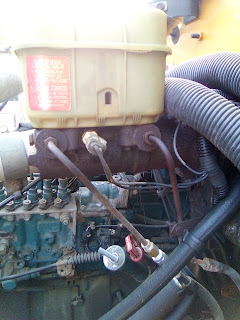So the wheelbarrow might have had something of a drinking problem but it served me well. Every shovel full of that first ten tons went into the wheelbarrow, got transported, dumped and raked. Barrowload after barrowload was moved until nothing was left of the pile.
Needless to say, 10 tons wasn't enough. I'd been told 3 would be sufficient by some uninformed calculator on a website. Thinking another 10 might do it - and another $400 - I upped the stakes to 15 tons then changed my mind and ordered 20, paying $600. Well, there you have it - it worked out that delivery was around $250 and the rest was the price of the grit. For the $1,000 it ended up costing, I could have had an extra 5 tons had I ordered it all at once. Next time, if there is a next time, I will just order 50 tons and be done with it!
My technique was simple - dump barrowloads of grit then rake the grit together ignoring vegetation. Once the grit was raked, I walked all over it, flattening it with my feet and then waited for rain. Since there wasn't a handy Medicine Man around willing to do a rain dance I had to wait for the downpours from the outer layers of hurricanes to tamp the grit down.
The rains came and did their job well. Thus it was time, after spending time tidying my workshop area away and moving my welding bench to a new location, to move the bus. I wondered how easily it would start given that it hadn't been started in months. Connecting the battery, the bus started instantly. All the gauges looked good so I started working the brake as I was pretty sure the pins had corroded from being left with the parking brake on for 2 years.
I worked the parking brake a couple of times then pumped the foot brake a couple of times then pressed it hard whereupon there was a loud pop noise that I heard over the engine. Then I heard the hydromax constantly whirring. That wasn't good. Checking underneath I could see some glistening leaves. That wasn't good either. Clearly there was a leak!
Before I started the bus I checked all the fluids - power steering fluid, radiator fluid, transmission fluid and engine oil. I did look at the brake fluid box and thought I saw a line so I classed that as being good. As I wasn't hitting the road I didn't check the tyres or the lights.
So, I drove the bus 30 feet into its new parking area. The footbrake was very soft indeed. It didn't go all the way to the floor but it was soft. The bus stopped on command without my needing to pull the handbrake. Having stopped, I turned the engine off and disconnected the battery. Then I looked under the hood.
That's the key to the braking system. That's a Bosch Hydromax electric brake booster. That takes my foot pressure and amplifies it, sending pressure to front and rear brakes. It seems that the front brakes are controlled from the rear tube and the back brakes from the front tube. Somewhere on the front tube will be the antilock braking system that stops the brakes from locking and thus allows me to keep steering in hard braking event.The problem turned out to be the back brake line. Notice how the front one is sparkly and new but the back one is crusty and old? When I broke down the last time I drove the bus, the mechanics must have changed the one brake line and not deemed the other one bad enough to switch out. Well, it has failed now and I'm going to have to knuckle down and do this myself as I'm miles away from any mechanics. This will be a good lesson in bus maintenance and should shed some of the mystery from hydraulic brakes. I will probably have to get underneath and work out where the pistons that get rusted solid are. I'm sure one or more are rusty again. I'm glad this happened in the yard. On the road would have been bad news indeed. I'll have to learn how to bleed brakes too.
While I was working on the parking area, I had sufficient left over grit to do a couple of other things. One was a patio area and another was a trash can corral. The neighborhood dogs have been knocking trash cans over and shredding the bags. Thus I built a corral using something called garden lumber. That's pretty close to being 2x4 but is far cheaper. Two layers of 36 inch rabbit wire around the corral, stitched together with a strand of galvanized wire to make a 6 foot fence worked wonderfully.
Talking of 2 x 4, since Covid hit, Lowes (hiss, spit) has really jacked up the price of their 2x4. It used to be $3.98 for an 8 foot length. It is now outrageous...
It is now $7.57 for an 8 foot length of treated 2x4. That is highway robbery when Home Depot according to their website charge just $4.10 for the same wood.







No comments:
Post a Comment